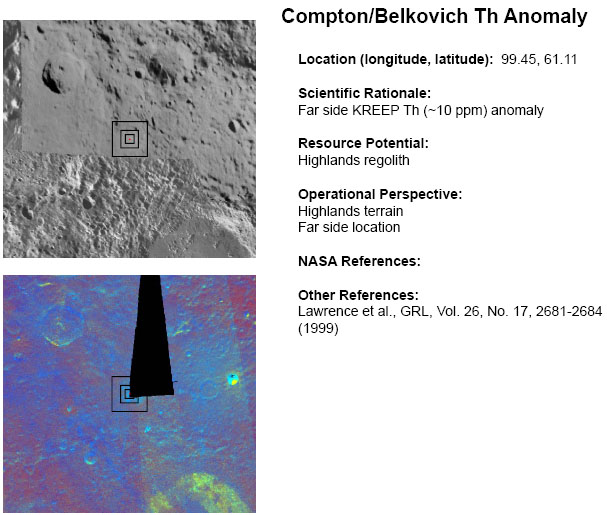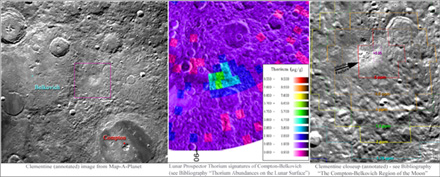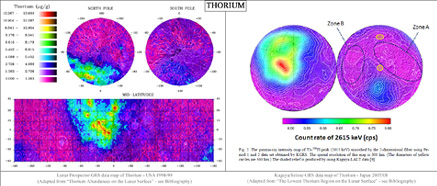Difference between revisions of "RoI - Compton-Belkovich Th Anomaly"
| Line 1: | Line 1: | ||
<div id="content_view" class="wiki" style="display: block"> | <div id="content_view" class="wiki" style="display: block"> | ||
=Compton/Belkovich Th Anomaly= | =Compton/Belkovich Th Anomaly= | ||
| − | ''(Tier 2 [ | + | ''(Tier 2 [[Cx35|Region of Interest]] for Constellation Program)''<br /> <br /> |
==Official NASA Overview== | ==Official NASA Overview== | ||
[[Image:ROI_-_Compton-Belkovich_Th_Anomaly.JPG|ROI_-_Compton-Belkovich_Th_Anomaly.JPG]]<br /> ''source: NASA [http://ser.sese.asu.edu/LSM/files/Cx-LROC-Tier2-FINAL.pdf Cx-LROC Tier 2 Targets] (PDF); see expanded details below''<br /> <div id="toc"> | [[Image:ROI_-_Compton-Belkovich_Th_Anomaly.JPG|ROI_-_Compton-Belkovich_Th_Anomaly.JPG]]<br /> ''source: NASA [http://ser.sese.asu.edu/LSM/files/Cx-LROC-Tier2-FINAL.pdf Cx-LROC Tier 2 Targets] (PDF); see expanded details below''<br /> <div id="toc"> | ||
| Line 8: | Line 8: | ||
==Scientific Rationale== | ==Scientific Rationale== | ||
===Farside KREEP Th (~ 10 ppm) anomaly=== | ===Farside KREEP Th (~ 10 ppm) anomaly=== | ||
| − | Lunar Thorium (Th) abundances on the lunar surface can aid in the various geological processes that formed during the moon's early history, and answer questions about its subsequent evolution over time. Signatures of the radioactive componant in Th show up in KREEP-like deposits more on the Moon's nearside rather than on its farside, and it's this relationship between the two components which signify one of the last crystalisation processes of a magma ocean that may have once globally covered the Moon. Recent, high resolution measurements by both the Lunar Prospector (USA ~ 1998-99) and [ | + | Lunar Thorium (Th) abundances on the lunar surface can aid in the various geological processes that formed during the moon's early history, and answer questions about its subsequent evolution over time. Signatures of the radioactive componant in Th show up in KREEP-like deposits more on the Moon's nearside rather than on its farside, and it's this relationship between the two components which signify one of the last crystalisation processes of a magma ocean that may have once globally covered the Moon. Recent, high resolution measurements by both the Lunar Prospector (USA ~ 1998-99) and [[Kaguya|Kaguya]] (Japan ~ 2007-08) space probes, however, do show that low concentrations of Th-KREEP deposits do exist on the farside; most especially found in zones around the [[South%20Pole-Aitken%20basin|South Pole-Aitken basin]], and odd anomalous regions such as exists at the Compton-Belkovich borders. Both Thorium and the KREEP-rich (K - Potassium, REE - rare earth elements, P - Phosphorus) deposits are believed to have formed between the lunar crust and mantle when less dense cumulates floated upwards during the moon's evolution.<br /> <br /> '''Compton-Belkovich Anomaly'''<br /> The Th deposits at Compton-Belkovich lie in a rugged feldspathetic highlands crust region between the two inner rings (250 and 350 km in diameter respectively) of the Humboltianum Basin lying some ~ 300 km away to its south-west. Moreover, they are found to sit on the eastern side of a saddle-like outcrop whose topography is higher in a north-south direction than east-west, and whose abundance of Th is higher than on any other measured location on the lunar surface. On closer analyses of both the LP/Kaguya data, the Th-anomaly at Compton-Belkovich was found to be that of an outcrop of alkali anorthosite similar to those samples taken on location from Apollos 12 and 14. Such anorthosites are a componant in rocks that have an evolved composition associated to the Mg-suite (old ferroan anorthosites > 4.4 Bn years old) of magmas that intruded throughout the moon's crust early in pre-4 billion year lunar history. The problem, however, with the Th-anomaly at Compton-Belkovich is that no Mg-suite of rocks have been identified, and it is possible that KREEP lithologies may lay hidden below the outcrop of alkali anorthosites. More research and sampling of the area thus needs to be carried put, firstly, because the processes involved with late crystallisation aren't quite fully understood and, secondly, the anomaly may be due to a new type of rock that presently isn't available in current collections to date. <span class="membersnap">- [http://www.wikispaces.com/user/view/JohnMoore2 [[Image:JohnMoore2-lg.jpg|16px|JohnMoore2]]] [http://www.wikispaces.com/user/view/JohnMoore2 JohnMoore2]</span><br /> <br /> |
* Gillis, J. J. ''et al'' (2002). [http://www.higp.hawaii.edu/~gillis/abstracts/LPSC33/a_l02g02.pdf The Compton-Belkovich Region of the Moon:Remotely Sensed Observations and Lunar Sample Association] from the 33rd Lunar and Planetary Conference (2002). | * Gillis, J. J. ''et al'' (2002). [http://www.higp.hawaii.edu/~gillis/abstracts/LPSC33/a_l02g02.pdf The Compton-Belkovich Region of the Moon:Remotely Sensed Observations and Lunar Sample Association] from the 33rd Lunar and Planetary Conference (2002). | ||
* Lawrence, D.J. ''et al'' (1999). [http://www.lunar-research-institute.org/images/science/1999/thorium_grl_1999.pdf High Resolution Measurements of Absolute Thorium Abundances on the Lunar Surface] - Geophysical Research Letters, Vol. 26, No. 17, 2681-2684(1999). | * Lawrence, D.J. ''et al'' (1999). [http://www.lunar-research-institute.org/images/science/1999/thorium_grl_1999.pdf High Resolution Measurements of Absolute Thorium Abundances on the Lunar Surface] - Geophysical Research Letters, Vol. 26, No. 17, 2681-2684(1999). | ||
| Line 28: | Line 28: | ||
==Additional Information== | ==Additional Information== | ||
| − | * [ | + | * [[Compton|Compton]] |
| − | * [ | + | * [[Bel%27kovich|Bel'kovich]] |
* [http://en.wikipedia.org/wiki/Radioactive_decay Radioactive] Thorium (232) has a half-life of upto 4.1 x 10^10 years. | * [http://en.wikipedia.org/wiki/Radioactive_decay Radioactive] Thorium (232) has a half-life of upto 4.1 x 10^10 years. | ||
| − | * Amongst the *[http://lunar.arc.nasa.gov/results/gamres.htm 10 elements] measured by the [http://lunar.arc.nasa.gov/ Lunar Prospector] mission which launched on 6 January 1998 and deliberately crashed near [ | + | * Amongst the *[http://lunar.arc.nasa.gov/results/gamres.htm 10 elements] measured by the [http://lunar.arc.nasa.gov/ Lunar Prospector] mission which launched on 6 January 1998 and deliberately crashed near [[Shoemaker|Shoemaker]] crater on 31 July 1999, an instrument onboard called the [http://lunar.arc.nasa.gov/results/gamma.htm Gamma Ray Spectrometer] was used to map the global abundance of thorium on the lunar surface. |
| − | * The [ | + | * The [[Kaguya|Kaguya]] spaceprobe which launched on the 14 September 2007 and that was also intentionally crashed near [[Gill|Gill]] crater on the 11 June 2009, used a similar type of instrument called the [http://www.kaguya.jaxa.jp/en/equipment/grs_e.htm Gamma Ray Spectrometer] to globally map the Moon for Thorium and other elements. |
| − | * Some other areas on the Moon where Thorium/KREEP signatures show up include: [ | + | * Some other areas on the Moon where Thorium/KREEP signatures show up include: [[Aristarchus|Aristarchus]], [[Arago|Arago]], [[Mairan|Mairan]], [[Aristillus|Aristillus]], [[Kepler|Kepler]], [[Copernicus|Copernicus]], [[Plato|Plato]], [[Montes%20Carpatus|Carpathian Mountains]] to [[Fra%20Mauro|Fra Mauro]] region, [[Van%20de%20Graaff|Van de Graaff]], [[Apennine%20Bench%20Formation|Apennine Bench Formation]], [[Montes%20Alpes|Alpes Mountains]], [[Sinus%20Iridum|Sinus Iridum]], [[Mare%20Nubium|Nubium Basin]], [[Tycho|Tycho]], [[Mare%20Humorum|Humorum Basin]]. |
<br /> *Thorium, Potassium, Uranium, Iron, Oxygen, Silicon, Aluminium, Calcium, Magensium, Lithium.<br /> <br /> | <br /> *Thorium, Potassium, Uranium, Iron, Oxygen, Silicon, Aluminium, Calcium, Magensium, Lithium.<br /> <br /> | ||
==LPOD Articles== | ==LPOD Articles== | ||
Revision as of 16:11, 15 April 2018
Contents
Compton/Belkovich Th Anomaly
(Tier 2 Region of Interest for Constellation Program)
Official NASA Overview

source: NASA Cx-LROC Tier 2 Targets (PDF); see expanded details below
Table of Contents
Scientific Rationale
Farside KREEP Th (~ 10 ppm) anomaly
Lunar Thorium (Th) abundances on the lunar surface can aid in the various geological processes that formed during the moon's early history, and answer questions about its subsequent evolution over time. Signatures of the radioactive componant in Th show up in KREEP-like deposits more on the Moon's nearside rather than on its farside, and it's this relationship between the two components which signify one of the last crystalisation processes of a magma ocean that may have once globally covered the Moon. Recent, high resolution measurements by both the Lunar Prospector (USA ~ 1998-99) and Kaguya (Japan ~ 2007-08) space probes, however, do show that low concentrations of Th-KREEP deposits do exist on the farside; most especially found in zones around the South Pole-Aitken basin, and odd anomalous regions such as exists at the Compton-Belkovich borders. Both Thorium and the KREEP-rich (K - Potassium, REE - rare earth elements, P - Phosphorus) deposits are believed to have formed between the lunar crust and mantle when less dense cumulates floated upwards during the moon's evolution.
Compton-Belkovich Anomaly
The Th deposits at Compton-Belkovich lie in a rugged feldspathetic highlands crust region between the two inner rings (250 and 350 km in diameter respectively) of the Humboltianum Basin lying some ~ 300 km away to its south-west. Moreover, they are found to sit on the eastern side of a saddle-like outcrop whose topography is higher in a north-south direction than east-west, and whose abundance of Th is higher than on any other measured location on the lunar surface. On closer analyses of both the LP/Kaguya data, the Th-anomaly at Compton-Belkovich was found to be that of an outcrop of alkali anorthosite similar to those samples taken on location from Apollos 12 and 14. Such anorthosites are a componant in rocks that have an evolved composition associated to the Mg-suite (old ferroan anorthosites > 4.4 Bn years old) of magmas that intruded throughout the moon's crust early in pre-4 billion year lunar history. The problem, however, with the Th-anomaly at Compton-Belkovich is that no Mg-suite of rocks have been identified, and it is possible that KREEP lithologies may lay hidden below the outcrop of alkali anorthosites. More research and sampling of the area thus needs to be carried put, firstly, because the processes involved with late crystallisation aren't quite fully understood and, secondly, the anomaly may be due to a new type of rock that presently isn't available in current collections to date. - JohnMoore2 JohnMoore2
- Gillis, J. J. et al (2002). The Compton-Belkovich Region of the Moon:Remotely Sensed Observations and Lunar Sample Association from the 33rd Lunar and Planetary Conference (2002).
- Lawrence, D.J. et al (1999). High Resolution Measurements of Absolute Thorium Abundances on the Lunar Surface - Geophysical Research Letters, Vol. 26, No. 17, 2681-2684(1999).
|
Left: Clementine image from Map-A-Planet. |
|
Left: Lunar Prospector Map of Thorium of the moon's entire surface (1998-99). |
Additional Information
- Compton
- Bel'kovich
- Radioactive Thorium (232) has a half-life of upto 4.1 x 10^10 years.
- Amongst the *10 elements measured by the Lunar Prospector mission which launched on 6 January 1998 and deliberately crashed near Shoemaker crater on 31 July 1999, an instrument onboard called the Gamma Ray Spectrometer was used to map the global abundance of thorium on the lunar surface.
- The Kaguya spaceprobe which launched on the 14 September 2007 and that was also intentionally crashed near Gill crater on the 11 June 2009, used a similar type of instrument called the Gamma Ray Spectrometer to globally map the Moon for Thorium and other elements.
- Some other areas on the Moon where Thorium/KREEP signatures show up include: Aristarchus, Arago, Mairan, Aristillus, Kepler, Copernicus, Plato, Carpathian Mountains to Fra Mauro region, Van de Graaff, Apennine Bench Formation, Alpes Mountains, Sinus Iridum, Nubium Basin, Tycho, Humorum Basin.
*Thorium, Potassium, Uranium, Iron, Oxygen, Silicon, Aluminium, Calcium, Magensium, Lithium.
LPOD Articles
Peaking Over the Limb, A New Mare to Study, Edge World.
General Bibliography
Mostly Thorium-related papers
- Forni, O. et al (2010). Large Scale Potassium-Thorium Fractionation Around Imbrium from the 41st Lunar and Planetary Science Conference (2010).
- Kobayashi, S. et al (2010). The Lowest Thorium Region on the Lunar Surface Imaged by Kaguya Gamma Ray Spectrometer from the 41st Lunar and Planetary Science Conference (2010).
- Hagerty, J. J. et al (2010). The Thorium Abundance Distribution of the Humorum Pyroclastic Deposit from the 41st Lunar and Planetary Science Conference (2010).
- Yamashita, N. (2009). Precise Observation of Uranium, Thorium, and Potassium on the Moon by the Selene GRS from the 40th Lunar and Planetary Science Conference (2009).
- Lawrence, D. L et al (2007). Global Spatial Deconvolution of Lunar Prospector Th Abundances - published in the Geophysical Research Letters, 34, L03201, doi:10.1029/2006GL028530, 7 February (2007).
- Lawrence, D. J. (2003). Small-area Thorium Features on the Lunar Surface - published in Journal of Geophysical Research, 4 September 2003. J.(E9), 5102, doi:10.1029/2003JE002050.
- Gasnault, O. et al (2001). Combined Analysis of Thorium and Fast Neutron Data at the Lunar Surface from the 32nd Lunar and Planet Science Conference (2001).
- Bradley, L. (2000). Thorium Mass Balance for the Moon from Lunar Prospectror and Sample Data: Implications for Thermal Evolution from the 31st Lunar and Planetary Science Conference (2000).
- Lawrence, D. J. et al (2000). Thorium Abundances on the Lunar Surface - published in the Journal of Geophysical Research, Vol. 105, No. E8, pages 20,307 – 20,331, August 25, (2000).
- Lawrence, D. J. et al (2000). A Comparison of Lunar Prospector Thorium and Magnetic Field Data Within South Pole Aitken Basin from the 31st Lunar and Planet Science Conference (2000).
- Elphic, R. C. (1999). Lunar Prospector Measurements of the Distribution of Incompatible Elements Gadolinium, Samarium, and Thorium from the 30th Lunar and Planetary Science Conference (1999).
- Lawrence, D. J. (1998). Global Elemental Maps of the Moon: The Lunar Prospector Gamma-Ray Spectrometer - published in Science, 4 September 1998: Vol. 281. no. 5382, pp. 1484 - 1489 DOI: 10.1126/science.281.5382.1484 (1998).
Mostly KREEP-related papers
- Arai, T. et al (2010). Support for a Prolonged KREEP Magmatism: U-PB Age of Zircon and Baddeleyite in Lunar Meteorite NWA 4485 from the 41st Lunar and Planetary Science Conference (2010).
- Jacobsen, S. B. et al (2010). The Isotopic Composition of the Lunar Crust and the Age and Origin of the Moon: Evidence from Lunar Soils from the 41st Lunar and Planetary Science Conference (2010).
- Taylor, G. J. et al (2010). Apollo 15 KREEP Basalts and Emplacemewnt of the Apennine Bench Formation from the 41st Lunar and Planetary Science Conference (2010).
- Borg, L. E. et al (2004). Prolonged KREEP Magmatism on the Moon Indicated by the Youngest Dated Lunar Igneous Rock - published in Nature 432, 209-211 (11 November 2004) | doi:10.1038/nature03070.
- Yongliao, Z. et al (2004). KREEP Rocks published in the Chinese Journal of Geochemistry, Vol 23, No.1, Jan 2004 10.1007/BF02841138 pages 65 - 70.
- Jolliff, B. L. et all (1999). Thorium Enrichment Within the Procellarum KREEP Terrane: The Record in Surface Deposits and Significance for Thermal Evolution - Workshop on New Views of the Moon 2: Understanding the Moon Through the Integration of Diverse Datasets, p. 31. The Smithsonian/NASA Astrophysics Data System.
- Lawrence, D. J. et all (1999). Delineating the Major KREEP-bearing Terranes on the Moon With Global Measurements of Absolute Thorium Abundances from the 30th Lunar and Planetary Science Conference (1999).
This page has been edited 1 times. The last modification was made by - tychocrater tychocrater on Jun 13, 2009 3:24 pm

